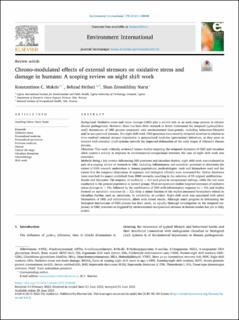| dc.description.abstract | Background: Oxidative stress and tissue damage (OSD) play a pivotal role as an early-stage process in chronic disease pathogenesis. However, there has been little research to better understand the temporal (χρόνος[chronos]) dimensions of OSD process associated with environmental (non-genetic, including behaviors/lifestyle) and/or occupational stressors, like night shift work. OSD processes have recently attracted attention in relation to time-resolved external stressor trajectories in personalized medicine (prevention) initiatives, as they seem to interact with circadian clock systems towards the improved delineation of the early stages of (chronic) disease process. Objectives: This work critically reviewed human studies targeting the temporal dynamics of OSD and circadian clock system's activity in response to environmental/occupational stressors; the case of night shift work was examined. Methods: Being a key stressor influencing OSD processes and circadian rhythm, night shift work was evaluated as part of a scoping review of research in OSD, including inflammatory and metabolic processes to determine the extent of OSD research undertaken in human populations, methodologies, tools and biomarkers used and the extent that the temporal dimensions of exposure and biological effect(s) were accounted for. Online databases were searched for papers published from 2000 onwards, resulting in the selection of 53 original publications. Results and discussion: The majority of studies (n = 41) took place in occupational settings, while the rest were conducted in the general population or patient groups. Most occupational studies targeted outcomes of oxidative stress/damage (n = 19), followed by the combination of OSD with inflammatory response (n = 10), and studies focused on metabolic outcomes (n = 12). Only a minor fraction of the studies measured biomarkers related to circadian rhythm, such as, melatonin, its metabolite, or cortisol. Night shift work was associated with select biomarkers of OSD and inflammation, albeit with mixed results. Although much progress in delineating the biological mechanisms of OSD process has been made, an equally thorough investigation on the temporal trajectory of OSD processes as triggered by environmental/occupational stressors in human studies has yet to fully evolve | |
